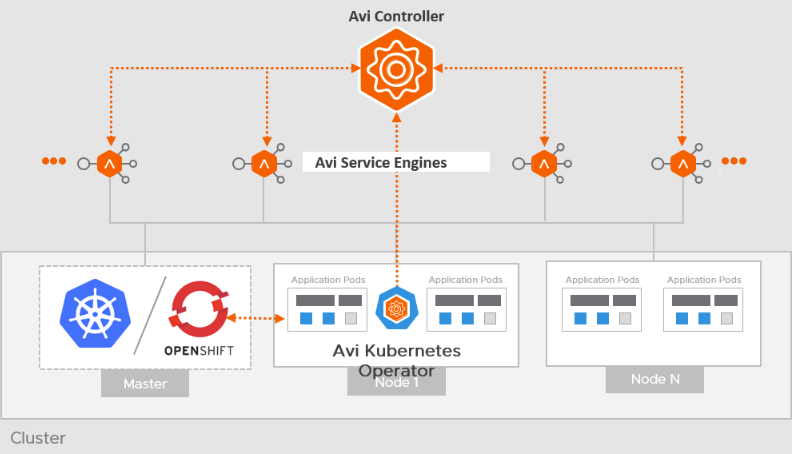What is AKO? #
AKO is an operator which works as an ingress controller and performs Avi-specific functions in an OpenShift/Kubernetes environment with the Avi Controller. It runs as a pod in the cluster and translates the required OpenShift/Kubernetes objects to Avi objects and automates the implementation of ingresses/routes/services on the Service Engines (SE) via the Avi Controller. ref: link

How to install AKO #
AKO is very easy installed with Helm. Four basic steps needs to be done.
- Create a namespace for AKO in your kubernetes cluster:
kubectl create ns avi-system - Add AKO Helm reposistory:
helm repo add ako https://projects.registry.vmware.com/chartrepo/ako - Get the current values for the versions you want:
helm show values ako/ako --version 1.9.1 > values.yaml - Deploy (after values have been edited to suit your environment):
helm install ako/ako --generate-name --version 1.9.1 -f values.yaml -n avi-system
AKO Helm values explained #
Before deploying AKO there are some parameters that should be configured, or most likely the deployment will fail. Below is an example file where the different fields are explained:
# Default values for ako.
# This is a YAML-formatted file.
# Declare variables to be passed into your templates.
replicaCount: 1
image:
repository: projects.registry.vmware.com/ako/ako #If using your own registry update accordingly
pullPolicy: IfNotPresent
### This section outlines the generic AKO settings
AKOSettings:
primaryInstance: true # Defines AKO instance is primary or not. Value `true` indicates that AKO instance is primary. In a multiple AKO deployment in a cluster, only one AKO instance should be primary. Default value: true.
enableEvents: 'true' # Enables/disables Event broadcasting via AKO
logLevel: WARN # enum: INFO|DEBUG|WARN|ERROR
fullSyncFrequency: '1800' # This frequency controls how often AKO polls the Avi controller to update itself with cloud configurations.
apiServerPort: 8080 # Internal port for AKO's API server for the liveness probe of the AKO pod default=8080
deleteConfig: 'false' # Has to be set to true in configmap if user wants to delete AKO created objects from AVI
disableStaticRouteSync: 'false' # If the POD networks are reachable from the Avi SE, set this knob to true.
clusterName: my-cluster # A unique identifier for the kubernetes cluster, that helps distinguish the objects for this cluster in the avi controller. // MUST-EDIT
cniPlugin: '' # Set the string if your CNI is calico or openshift. enum: calico|canal|flannel|openshift|antrea|ncp
enableEVH: false # This enables the Enhanced Virtual Hosting Model in Avi Controller for the Virtual Services
layer7Only: false # If this flag is switched on, then AKO will only do layer 7 loadbalancing.Must be true if used in a TKC cluster / Tanzu with vSphere
# NamespaceSelector contains label key and value used for namespacemigration
# Same label has to be present on namespace/s which needs migration/sync to AKO
namespaceSelector:
labelKey: ''
labelValue: ''
servicesAPI: false # Flag that enables AKO in services API mode: https://kubernetes-sigs.github.io/service-apis/. Currently implemented only for L4. This flag uses the upstream GA APIs which are not backward compatible
# with the advancedL4 APIs which uses a fork and a version of v1alpha1pre1
vipPerNamespace: 'false' # Enabling this flag would tell AKO to create Parent VS per Namespace in EVH mode
istioEnabled: false # This flag needs to be enabled when AKO is be to brought up in an Istio environment
# This is the list of system namespaces from which AKO will not listen any Kubernetes or Openshift object event.
blockedNamespaceList: []
# blockedNamespaceList:
# - kube-system
# - kube-public
ipFamily: '' # This flag can take values V4 or V6 (default V4). This is for the backend pools to use ipv6 or ipv4. For frontside VS, use v6cidr
### This section outlines the network settings for virtualservices.
NetworkSettings:
## This list of network and cidrs are used in pool placement network for vcenter cloud.
## Node Network details are not needed when in nodeport mode / static routes are disabled / non vcenter clouds.
nodeNetworkList: []
# nodeNetworkList:
# - networkName: "network-name"
# cidrs:
# - 10.0.0.1/24
# - 11.0.0.1/24
enableRHI: false # This is a cluster wide setting for BGP peering.
nsxtT1LR: '' # T1 Logical Segment mapping for backend network. Only applies to NSX-T cloud.
bgpPeerLabels: [] # Select BGP peers using bgpPeerLabels, for selective VsVip advertisement.
# bgpPeerLabels:
# - peer1
# - peer2
vipNetworkList: [] # Network information of the VIP network. Multiple networks allowed only for AWS Cloud.
# vipNetworkList:
# - networkName: net1
# cidr: 100.1.1.0/24
# v6cidr: 2002::1234:abcd:ffff:c0a8:101/64 # Setting this will enable the VS networks to use ipv6
### This section outlines all the knobs used to control Layer 7 loadbalancing settings in AKO.
L7Settings:
defaultIngController: 'true'
noPGForSNI: false # Switching this knob to true, will get rid of poolgroups from SNI VSes. Do not use this flag, if you don't want http caching. This will be deprecated once the controller support caching on PGs.
serviceType: ClusterIP # enum NodePort|ClusterIP|NodePortLocal. NodePortLocal can only be used if Antrea is the CNI
shardVSSize: LARGE # Use this to control the layer 7 VS numbers. This applies to both secure/insecure VSes but does not apply for passthrough. ENUMs: LARGE, MEDIUM, SMALL, DEDICATED
passthroughShardSize: SMALL # Control the passthrough virtualservice numbers using this ENUM. ENUMs: LARGE, MEDIUM, SMALL
enableMCI: 'false' # Enabling this flag would tell AKO to start processing multi-cluster ingress objects.
### This section outlines all the knobs used to control Layer 4 loadbalancing settings in AKO.
L4Settings:
defaultDomain: '' # If multiple sub-domains are configured in the cloud, use this knob to set the default sub-domain to use for L4 VSes.
autoFQDN: default # ENUM: default(<svc>.<ns>.<subdomain>), flat (<svc>-<ns>.<subdomain>), "disabled" If the value is disabled then the FQDN generation is disabled.
### This section outlines settings on the Avi controller that affects AKO's functionality.
ControllerSettings:
serviceEngineGroupName: Default-Group # Name of the ServiceEngine Group.
controllerVersion: '' # The controller API version
cloudName: Default-Cloud # The configured cloud name on the Avi controller.
controllerHost: '' # IP address or Hostname of Avi Controller
tenantName: admin # Name of the tenant where all the AKO objects will be created in AVI.
nodePortSelector: # Only applicable if serviceType is NodePort
key: ''
value: ''
resources:
limits:
cpu: 350m
memory: 400Mi
requests:
cpu: 200m
memory: 300Mi
securityContext: {}
podSecurityContext: {}
rbac:
# Creates the pod security policy if set to true
pspEnable: false
avicredentials:
username: ''
password: ''
authtoken:
certificateAuthorityData:
persistentVolumeClaim: ''
mountPath: /log
logFile: avi.log
More info here

